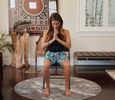If you were to ask me what my favorite and most useful yoga prop is, unsurprisingly I would say the Manduka PRO Black Mat, which has become a legendary product for yoga enthusiasts worldwide. However, if I were to pick a “second” favorite, hands down it would be our signature unBlok, a unique yoga prop that we created as a high-performance tool to literally support you more comfortably in your yoga practice.
Why is it called the unBlok?
First of all, this block has the ideal ergonomic design for those of us who spend hours every day on a keyboard or behind the wheel, to passively release and unblock those “gnarly” tension knots in the thoracic muscles of the back… Secondly, the name honors this block’s unique departure from the standard yoga block, with its dual curved profile that gives unmatched comfort and support for chest openers and passive backbends. And lastly, as one reviewer recently said and we wholeheartedly agree – it’s fun to say!
Inspiration behind the design
The story how this block came about occurred during the first remodeling of our yoga center in 2010. We had dozens of standard blocks and long foam rollers, and the architect we hired (me) was trying to figure out a way to store them efficiently. After struggling to redesign our shelves, it came to our product designer (also me) that maybe we could think outside the “block”, and redesign the rollers and blocks into a single versatile prop that was stackable on a shelf and multi-functional. It was one of those many “aha” moments that have happened over the course of Manduka’s history, a company born 23 years ago by yoga teachers and practitioners who had an obsession for examining things we use every day and creatively find ways to innovative them. And like most thoughtful products, the final design of the unBlok was a trial and error process, that took many attempts and months of testing before arriving at this beautiful, eco-friendly, 100% recycled foam block.
Creative uses for the unBlok
Traditionally yoga blocks have been used for restorative and therapeutic practices and there are many – spinal support in passive, reclining backbends, chest and shoulder openers; hand support for standing poses, pelvic support for seated forward bends, and many more.







